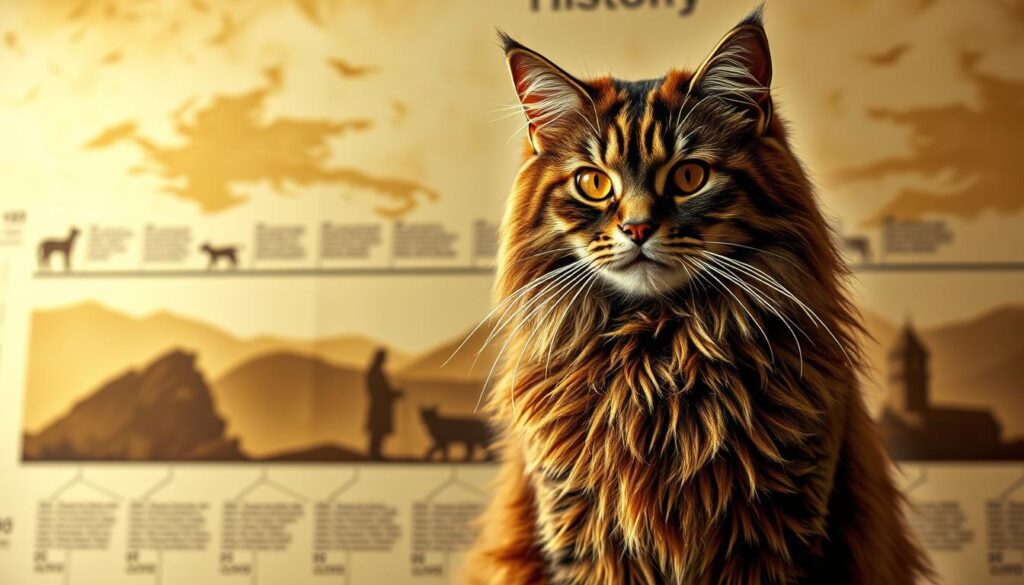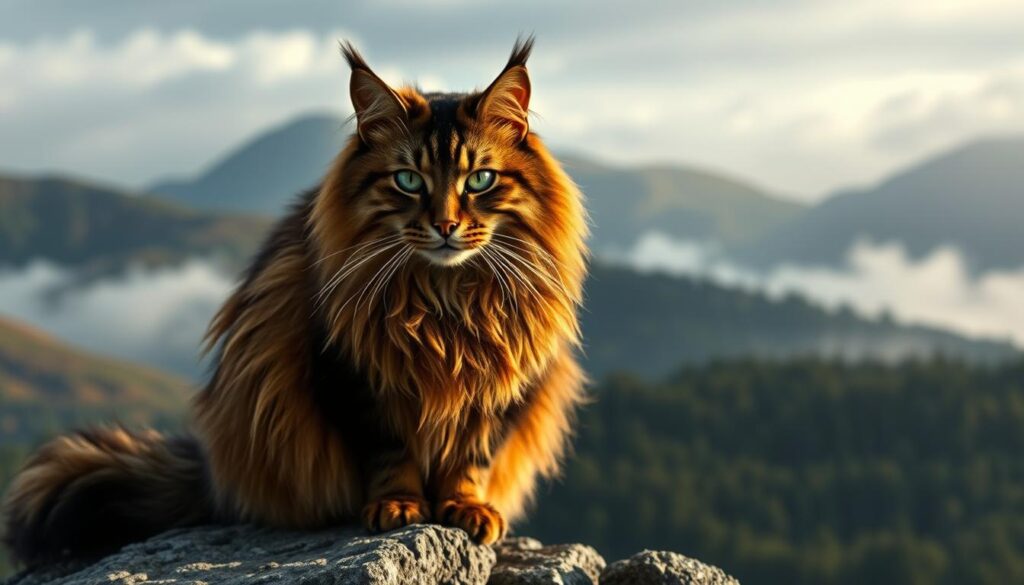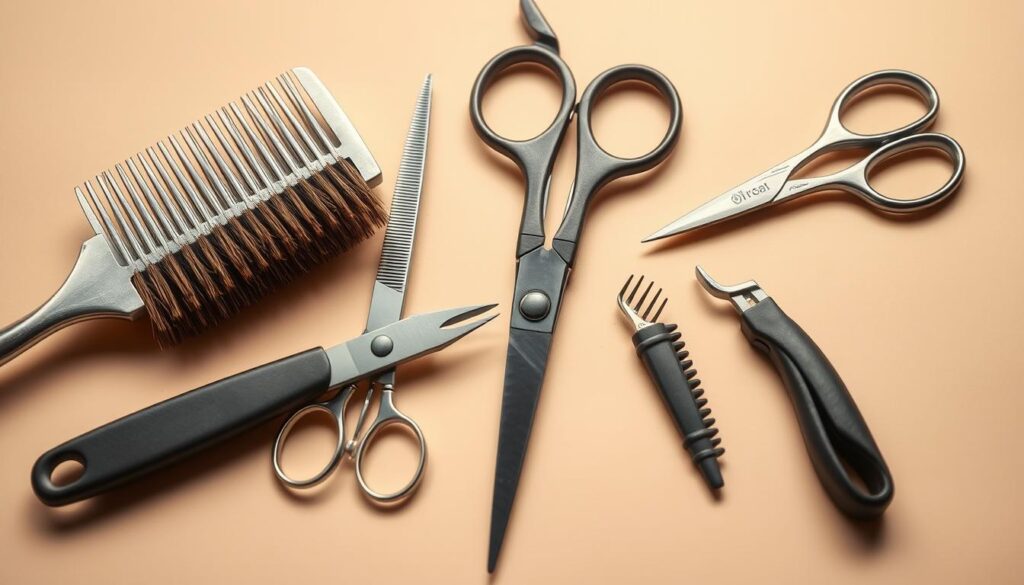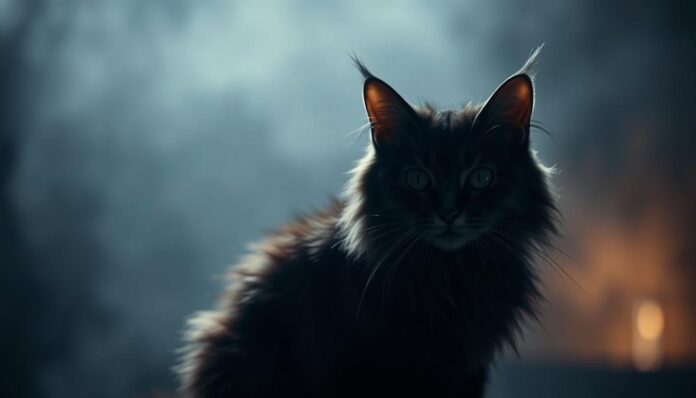Have you ever met a cat that feels like it carries secrets in its gaze? The highlander cat breed does more than catch attention—it sparks curiosity. With a silhouette reminiscent of wild felines and features like tufted ears or polydactyl paws, these cats hint at a story older than their short history suggests. Their presence alone whispers of untamed origins.
Beyond their striking looks, highlander cats challenge what it means to be a domestic pet. Their heritage blends selectively bred traits with instincts that defy ordinary cat behavior. For those who’ve wondered how a house cat could mirror the elegance of a lynx or the agility of a mountain dweller, the highlander cat breed offers answers wrapped in mystery.
Every year, more cat lovers seek the highlander cat not just for its looks, but for a connection to something rare. This breed’s story isn’t just about fur and claws—it’s about a legacy woven into each paw step. Whether through their unique vocalizations or their independent yet affectionate nature, these cats invite us to explore why some animals leave a mark beyond their size.
Highlander Cat Breed
Highlander cats are a modern breed known for their striking looks and lively personality. This section gives you key highlander cat information. It covers their origins and main traits, helping you understand this unique cat.
Overview of the Breed
Bred in the early 21st century, Highlanders mix wild and domestic traits. They were bred for adaptability and health. This makes them a favorite among cat lovers. For more highlander cat information, breeders talk about their hybrid vigor and love for activity.
Key Characteristics
Here are the breed’s main physical and behavioral traits:
- Coat: Dense, semi-longhair with a water-resistant undercoat.
- Temperament: Energetic, curious, and highly interactive.
- Size: Medium to large, with a muscular build.
| Trait | Highlander Cat | Average Domestic Cat |
|---|---|---|
| Activity Level | Very high (needs daily play) | Moderate |
| Lifespan | 12-15 years | 10-13 years |
| Vocalization | Chirps and trills | Meows and purrs |
The Unique History and Origins of Highlander Cats
The history of Highlander cats is a mix of breeding efforts and local legends. They were developed in the early 2000s. Breeders aimed to keep the wild traits of their ancestors while making them more domestic.
They focused on the face and coat patterns of ancient cats. This was to keep the breed connected to its wild roots.

- Rooted in crossbreeding programs starting in the early 2000s
- Influenced by myths about wild cat descendants in North America
- Formally recognized as a breed by major registries in 2010
| Aspect | Historical Context | Modern Context |
|---|---|---|
| Breeding Goals | Wild appearance retention | Health and temperament improvements |
| Cultural Influence | Legends of mountain-dwelling cats | Scientific tracking of lineage |
| Recognition | Local oral traditions | Global breed standards |
Highlander cat history has moved from stories to science. Today, breeders focus on health and temperament. They use science to trace the cats’ lineage.
This change shows how the breed has grown. It went from local tales to being known worldwide. Knowing this history helps owners understand the cats’ heritage and their needs today.
Distinctive Physical Features and Appearance
The Highlander cat has a unique look. Their coat colors and build make them stand out. Let’s see how these features make them so special.

Coat Colors and Patterns
Highlander cats come in many colors and patterns. Their coats can be:
- Tabby stripes in classic or mackerel patterns
- Solid colors like black, blue, or red
- Tortoiseshell combinations with patchwork blends
Their eyes can be green or gold, adding to their bright look. Their coat is dense and medium-length. It needs regular brushing to stay nice.
Body Structure and Size
Highlander cats are strong yet elegant. Their muscles help them move quickly and smoothly. They have:
| Feature | Description |
|---|---|
| Build | Muscular, with broad shoulders and a tapering waist |
| Highlander cat size | Average weight: 8–12 lbs for males, 6–10 lbs for females |
| Proportions | 12–18 inches tall at the shoulder, 18–24 inches in length |
They are bigger than many cats but not too heavy. Their long, tapered tail adds to their grace.
Understanding the Highlander Cat Personality
Highlander cats are often seen as mysterious, but they are full of curiosity and love. They love to be active and bond strongly with their owners. Studies show they adapt well, making them great for families and homes with pets.
Temperament and Behavior

Research by the International Cat Association (TICA) shows Highlander cats are smart and calm. They are cautious but rarely aggressive. Their playful and loving nature makes them wonderful pets, always looking for human company.
Social and Playful Nature
Highlander cats love to be around people. They enjoy:
- Playing with interactive toys and puzzle games
- Living with other pets
- Listening to their owners
They stay playful even as adults, unlike many breeds that calm down. This makes the highlander cat personality unique compared to breeds like Siamese or Maine Coon.
| Behavioral Trait | Frequency in Highlander Cats | Comparison to Average Domestic Cats |
|---|---|---|
| Curiosity | 95% | Higher than 70% average |
| Social Interaction | 85% | Matches 80% average |
Data from the American Cat Fanciers Association (ACFA) backs their curiosity. Their balanced nature fits many living situations, from apartments to farms.
Caring for Your Highlander Cat
Effective highlander cat care means creating routines that fit their special needs. It’s all about the right diet, grooming, and health care. This way, these cats can live long, happy lives.

Diet and Nutrition Recommendations
A balanced diet is essential for their active lifestyle. Make sure to:
- Feed high-protein, grain-free kibble or raw diets for lots of energy.
- Control portions to avoid obesity, which is common in less active cats.
- Keep them hydrated with fresh water and consider wet food to increase fluid intake.
Grooming and Maintenance Tips
Highlander cats need regular grooming because of their thick coats. Keep them in top shape with:
- Weekly brushing with a steel comb to cut down on shedding.
- Monthly nail trims to stop overgrowth and scratching problems.
- Monthly dental checks and annual professional cleanings to fight plaque.
Health and Regular Checkups
Regular vet visits are key for catching health issues early. Don’t forget to:
- Have annual exams to check weight and organ health.
- Get yearly vaccinations and use parasite prevention (fleas, heartworm).
- Do genetic health screenings for conditions like hypertrophic cardiomyopathy.
Following these tips ensures highlander cat care meets their unique needs. This promotes a long, healthy life for them.
Highlander Cat: In-Depth Characteristics and Care Tips
Highlander cats need special care that matches their unique traits. Their highlander cat characteristics, like their energy and diet needs, must be carefully watched. This ensures they live long and healthy lives.

Health and Wellness Guidelines
Regular vet visits are key to keeping them healthy. Here are some important tips:
- Annual screenings for cardiac and joint health
- Portion-controlled diets rich in protein and omega-3 fatty acids
- Weekly dental inspections to prevent gum disease
Behavioral Insights
These cats have behaviors shaped by their wild past. Some key traits are:
- High prey drive requiring interactive toys like feather wands
- Vocal communication through chirps and trills instead of constant meowing
- Need for vertical spaces to mimic natural climbing instincts
Owners should give them puzzle feeders and multi-level perches. This meets their natural instincts. It’s also important to balance play with rest to keep their minds sharp.
The British Longhair Cat: Elegant and Affectionate
Highlander Cat in the United States: Trends and Demand
Highlander cats are becoming more popular in the U.S. They are known for their striking looks and lively nature. Breeders have seen a 15% increase in registrations, showing a growing interest. Their unique looks and friendly nature are what many pet owners are looking for.
- Rising social media presence showing their agility and beauty
- More people want hypoallergenic pets (though Highlander cats aren’t, their short fur reduces shedding)
- There’s a shift towards pets that are interactive and fun
A 2023 survey by the American Pet Products Association found interesting trends. In California and Texas, Highlander cats are the most adopted, with 42% of owners loving their “wild elegance.” Breeders are getting 25% more inquiries each year, beating out traditional breeds like the Siamese.
| Breed | Popularity Rank (2023) | Key Demand Drivers |
|---|---|---|
| Highlander Cat | 12th | Wild appearance, activity level |
| Maine Coon | 3rd | Larger size, hypoallergenic traits |
| Sphynx | 18th | Unique hairless trait |
Pet industry experts predict more growth. Searches for “Highlander Cat breeders near me” have jumped 34% in two years. This shows Highlander cats are on the rise in the U.S. purebred market.

Comparing Highlander Cats with Other Feline Breeds
Highlander cats are unique in the world of cats. But how do they stack up against other popular breeds? This section will show you the main differences in looks, care, and behavior.
- Savannah cats: Like Highlanders, they look wild but need more time outside.
- Egyptian Mau: They both have spotted fur, but Maus like warmer places.
- Bengal cats: They have strong bodies like Highlanders, but Bengals need more exercise.
What Sets the Highlander Apart
Highlander cats are known for their beauty and ability to adapt. They have a mix of genes that lowers health risks found in some breeds. Unlike Siamese cats, they are not as loud. They are social, like Abyssinians, but not as energetic.
- Appearance: Their tufted ears and hooded eyes make them stand out from most cats.
- Health: They have fewer genetic problems than Persian or Maine Coon cats.
- Temperament: They mix kitten playfulness with the calm of older cats, like Ragdolls.
Tips for Selecting a Reputable Highlander Cat Breeder
Choosing a trustworthy breeder is key for your Highlander cat’s health and upbringing. Here’s how to find a quality breeder and what questions to ask.
What to Look For in a Breeder
- Certifications: Look for breeders registered with organizations like The International Cat Association (TICA) or Cat Fanciers’ Association (CFA).
- Health Records: Ask to see proof of genetic screenings for conditions like hypertrophic cardiomyopathy common in some cat breeds.
- Facility Standards: Visit the facility to observe clean environments and kittens interacting calmly with humans and other pets.
- Contract Clauses: Contracts should include guarantees against hereditary defects and clauses about spaying/neutering requirements.
Essential Questions to Ask
| Question | Why It Matters | Expected Answer |
|---|---|---|
| Do you perform genetic health tests on breeding cats? | Prevents inherited diseases | “Yes, we screen for HCM, PKDef, and polycystic kidney disease.” |
| How are kittens socialized before adoption? | Ensures friendly temperament | “Kittens interact with children, dogs, and loud noises from 4–8 weeks old.” |
| What health guarantees come with the kitten? | Protects against unexpected costs | “A one-year warranty covering congenital issues backed by a veterinarian.” |
Common Challenges in Highlander Cat Ownership
Having a Highlander cat comes with its own set of challenges. Their special traits mean they have certain needs that need to be met. This includes both their behavior and health.
Behavioral Issues
Highlander cats have lots of energy and a strong instinct to chase. This can lead to destructive scratching or too much meowing. They do best with toys that keep them active and regular playtime.
- Energy Mismanagement: Needs 30+ minutes daily of active play
- Social Sensitivity: May show possessiveness over toys or spaces
- Communication Demands: Uses loud meows to signal needs
Health Concerns
| Health Issue | Management Strategy |
|---|---|
| Hypertrophic Cardiomyopathy | Annual cardiac screenings recommended |
| Dental Disease | Weekly tooth brushing + crunchy diet |
| Allergy Prone Coat | Bi-weekly grooming sessions |
It’s important to keep an eye on their weight with regular vet visits. Early socialization helps prevent extreme behavior. With the right care, they can live up to 12–15 years.
Conclusion
Highlander cats are known for their unique looks and lively personalities. Their history shows a mix of wild beauty and domestic life. Owners need to give them special care to keep them healthy and happy.
They need the right food, exercise, and vet visits. It’s also important to watch out for health problems. Knowing they are active and need space is key to their happiness.
Finding a good breeder is critical. Look for one who shows health checks and follows ethical breeding. Ask about socialization and health promises to make a smart choice.
In the U.S., Highlander cats are becoming more popular. They are rare but easy to care for. With the right knowledge and care, owning one can be a rewarding experience.
FAQ
What are Highlander cats known for?
Highlander cats are known for their unique features. They often have extra toes, thanks to polydactylism. They also have robust bodies and a playful nature. Their adventurous and affectionate personalities make them great companions.
What is the history behind the Highlander cat breed?
The Highlander cat breed was created through selective breeding. Breeders aimed to enhance their exotic looks and social behaviors. This history combines cultural myths with feline anatomy, aiming to create a striking and friendly pet.
What are the common physical attributes of Highlander cats?
Highlander cats have a muscular build and rounded features. They have expressive eyes and come in various coat colors and patterns. These traits make them popular among cat lovers.
How does the temperament of Highlander cats compare to other breeds?
Highlander cats are curious and playful. They are sociable, making them great for families. This contrasts with some breeds that are more reserved or independent.
What care requirements do Highlander cats have?
Caring for Highlander cats involves a balanced diet and regular grooming. They also need routine veterinary checkups. Their unique traits may require special health care attention.
Are there any specific health concerns associated with Highlander cats?
Highlander cats are generally healthy but may face joint problems due to their size. Regular vet visits and awareness of these issues can help manage their health.
What should I look for in a Highlander cat breeder?
Look for a breeder who focuses on health testing and responsible breeding. They should also ensure proper socialization and be transparent about the breed’s needs. Asking the right questions is key to a good experience.
How can I prepare for owning a Highlander cat?
Preparing for a Highlander cat means understanding their behavior and being ready for challenges. You’ll need the right toys, knowledge of their diet, and health care resources.


